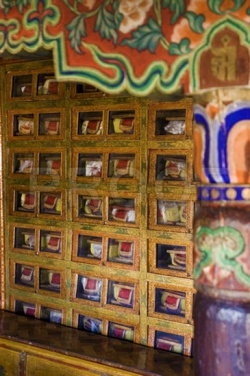Difference between revisions of "Inner Tantras"
(Created page with "The Inner Tantras are the final three divisions in the ninefold division of practice according to the Nyingma school of Tibetan Buddhism. They comprise the Mahayoga, Anuyoga a...") |
|||
| Line 1: | Line 1: | ||
| − | The Inner Tantras are the final three divisions in the ninefold division of practice according to the Nyingma school of Tibetan Buddhism. They comprise the Mahayoga, Anuyoga and Atiyoga. This system divides the whole of the Buddhist path into three divisions of three and is in contrast to the division of the Sarma, or New Translation schools (Gelug, Kagyu and Sayka) which use a fourfold division. The three divisions of the Inner Tantra correspond roughly to the highest category of tantras of the New Translation schools, there known as Anuttarayoga Tantra. | + | [[File:002-3.jpg|thumb|250px|]] |
| + | The Inner Tantras are the final three divisions in the ninefold division of practice according to the [[Nyingma]] school of [[Tibetan Buddhism]]. They comprise the [[Mahayoga]], [[Anuyoga]] and [[Atiyoga]]. This system divides the whole of the Buddhist path into three divisions of three and is in contrast to the division of the Sarma, or New Translation schools ([[Gelug]], [[Kagyu]] and [[Sayka]]) which use a fourfold division. The three divisions of the Inner Tantra correspond roughly to the highest category of tantras of the New Translation schools, there known as [[Anuttarayoga Tantra]]. | ||
The three divisions of the Inner Tantras are: | The three divisions of the Inner Tantras are: | ||
| − | + | *Mahayoga | |
| − | + | *Anuyoga | |
| − | + | *Atiyoga also known as [[Dzogchen]] or the Great Perfection. | |
Other schools call them "Father Tantras" (Wyl. pha rgyud), "Mother Tantras" (Wyl. ma rgyud) and "Non-Dual Tantras" (Wyl. gnyis med kyi rgyud) Among other factors, the three divisions differ in terms of the emphasis they place on the generation stage and completion stage of tantric practice. The Mahayoga emphasizes the generation stage, Anuyoga the completion stage and Atiyoga the synthesis and transcendence of both. | Other schools call them "Father Tantras" (Wyl. pha rgyud), "Mother Tantras" (Wyl. ma rgyud) and "Non-Dual Tantras" (Wyl. gnyis med kyi rgyud) Among other factors, the three divisions differ in terms of the emphasis they place on the generation stage and completion stage of tantric practice. The Mahayoga emphasizes the generation stage, Anuyoga the completion stage and Atiyoga the synthesis and transcendence of both. | ||
| Line 12: | Line 13: | ||
{{W}} | {{W}} | ||
| − | [[Category: | + | [[Category:Nyingma Texts]] |
| + | [[Category:Tantras]] | ||
Revision as of 04:08, 19 June 2013
The Inner Tantras are the final three divisions in the ninefold division of practice according to the Nyingma school of Tibetan Buddhism. They comprise the Mahayoga, Anuyoga and Atiyoga. This system divides the whole of the Buddhist path into three divisions of three and is in contrast to the division of the Sarma, or New Translation schools (Gelug, Kagyu and Sayka) which use a fourfold division. The three divisions of the Inner Tantra correspond roughly to the highest category of tantras of the New Translation schools, there known as Anuttarayoga Tantra.
The three divisions of the Inner Tantras are:
- Mahayoga
- Anuyoga
- Atiyoga also known as Dzogchen or the Great Perfection.
Other schools call them "Father Tantras" (Wyl. pha rgyud), "Mother Tantras" (Wyl. ma rgyud) and "Non-Dual Tantras" (Wyl. gnyis med kyi rgyud) Among other factors, the three divisions differ in terms of the emphasis they place on the generation stage and completion stage of tantric practice. The Mahayoga emphasizes the generation stage, Anuyoga the completion stage and Atiyoga the synthesis and transcendence of both.
As well as being differentiated in terms of emphasis in practice, the three categories of Inner Tantra are also textual categories, with lists of texts assigned to each category; for which see the individual articles for each section.
